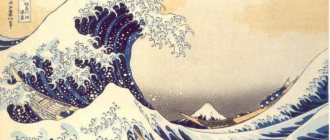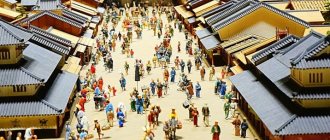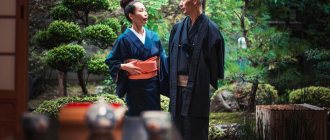HomeTourists TOP 10
In Japan, only 12 castles have survived from the Middle Ages and the beginning of the modern era. “Vestnik ATOR” and JNTO present a hit parade of the most authentic and well-preserved “samurai ancestral nests”.
It should be remembered that many castles in Japan, known to tourists today, are later reconstructions of ancient buildings: they were not spared by fires, earthquakes, wars and political vicissitudes.
For example, the tourist-favorite castle in Nagoya was rebuilt in 1959 after American bombing during World War II destroyed it.
And the most beautiful castle in Osaka was demolished during the Meiji Revolution in the 19th century, rebuilt only in 1931, was destroyed by bombing during the war, and then restored a second time only in 1997. We should pay tribute to Japanese builders and restorers - they recreated ancient structures with great accuracy, and now these are points of attraction for tourists and decorations of Japanese cities
But in this review we will talk about several castles in Japan that have survived to our time in more or less original form. Interestingly, most of them have poetic “bird” names.
HIMEJI CASTLE
Age: built in the 17th century. (in 1609).
Feature: One of the best preserved stone castles in Japan.
Himeji Castle, also called White Heron Castle, is a UNESCO World Heritage Site. One of the 12 remaining medieval castles in Japan, it is a must-see for any tourist who wants to learn about Japanese medieval architecture.
The first lines of defensive structures that have not reached us were built here in the 15th century, and the castle built in 1609 has survived to this day - consisting of 80 buildings and towers connected by stone labyrinths.
There are more than 1,000 cherry trees in the castle garden, and the Koko-en cherry orchards, established during the Edo period, surround the castle outside as well, so it gets quite crowded during cherry blossom season - and if you don't like crowds, it's best to visit the castle out of season. .
Ticket price: part of the castle can be viewed for free (entrance through the Otemon gate), the other part of the castle (main) is paid (entrance through the Hishi gate), ticket price is 1 thousand yen. Here you can climb to several observation platforms and take beautiful photographs of the surrounding area. You can take a boat ride around the castle for the same price of 1000 yen (on weekends and holidays).
How to get there: You need to take the train to Himeji Station. Next - 5 minutes by bus or 20 minutes on foot to Otemon Street.
“The Magnificent Dozen” – medieval castles that have survived to this day
There are many castles in Japan, but only twelve of them (*1), built no later than the Edo period (1603-1868), have the main tenshukaku tower preserved in its original form. The majestic castles with grandiose towers built by Oda Nobunaga (1534-1582) and Toyotomi Hideyoshi (1537-1598) are the embodiment of the strength and power that these great Japanese commanders possessed as they unified Japan. And although history knows many examples when a Japanese castle did not have a central tenshukaku tower, nevertheless, it was this multi-stage structure that rose to the sky that, as a rule, became the symbol of the entire castle complex.
Tenshukaku Tower at Hikone Castle (©cmeg.jp)
Beginning in the 7th century, mountain fortresses and military fortifications surrounded by stone walls began to appear in Japan. In the 15th-16th centuries, during the Sengoku period, castle construction reached its peak. It was during this period that the towers of Himeji, Hikone and Matsumoto castles, which are objects of national cultural heritage, were built. The owner of the castle, as a rule, lived at the foot of the hill on which the tower was located, and used the castle as a mountain shelter when attacked by enemies.
The castles differed from each other in shape and size, but as for the architectural features, the most characteristic feature was the ring structure, which included three fortification lines: hommaru - the first ring of fortifications, nino no maru - the second ring, san no maru - third ring. The main tenshukaku tower was located in the first ring; an almost vertical stone wall was erected around the perimeter, around which a moat was dug. The owner of the castle determined strategically important points on the territory of the hommaru for the gates and auxiliary towers of the yagura. At the foot of the castle, merchants opened their shops and gradually trade districts were formed, called the “lower city”. However, unlike Europe, cities never arose inside the fortress walls in Japan. Some feudal lords laid out gardens around their castles. Today, the most famous examples of such garden architecture are the Kenrokuen Garden in Kanazawa and the Korakuen Garden in Okayama.
After the Battle of Sekigahara (1600), which was won by Tokugawa Ieyasu (1543-1616), the country entered a new, relatively calm period. Under centralized power, castles and the cities formed around them began to play the role not so much of military fortifications, but of economic and political centers. In 1615, the shogunate issued a decree prohibiting daimyos from having more than one castle in their territories. The feudal lords were ordered to keep one castle for themselves and destroy the rest. Restrictions were also imposed on the redevelopment of existing castles and the construction of new ones was completely prohibited. As a result of the Meiji Restoration (1868), a major administrative and political reform took place: in 1871, the system of feudal han provinces was abolished and prefectures were established. In 1873, the new government issued a decree to liquidate the castles, and many of the historical buildings that remained at that time were destroyed. Some castles burned down in fires.
MATSUMOTO CASTLE
Age: the castle was built in the 15th century.
Feature : surrounded by a moat, the castle has the oldest five-story wooden citadel in Japan.
Matsumoto Castle is one of the most impressive historical castles in Japan, and one of the most famous, and is the symbol of the city of Nagano. The castle looks gloomy and stern, which is why its second name is “Raven Castle”. At night the castle is beautifully illuminated. Beautiful Japanese carps and swans swim in the castle moat.
The castle hosts numerous seasonal festivals (taiko drum festival in summer, soba noodle festival in autumn and ice sculpture festival in winter). During the day, actors in samurai and ninja costumes walk around the park for tourists - children who love to take pictures with Japanese heroes are especially welcome.
Ticket price : the area surrounding the castle is free to visit (there are a lot of sakura in the park around the castle, so there are always a lot of people here in April). For a nominal fee you can also go inside the castle: here you can see the palace interiors where the nobility lived, and there is an interesting small exhibition of ancient weapons. You can also go up to the observation deck - from here there is a beautiful view of the mountains.
How to get there : by JR trains from Shinjuku Station in Tokyo, as well as from Nagoya (go to Matsumoto Station).
Next - 15 minutes on foot or 5 minutes on the Town Sneaker tourist bus.
Types of castles: mountain, lowland, coastal
Mountain Castle – Yamajiro
Ruins of Takeda Castle in Hyogo Prefecture
(©cmeg.jp)
Mountain-plain castles – Hirayama-jiro
Himeji Castle, National Cultural Property, Hyogo Prefecture
(©cmeg.jp)
Kumamoto Castle, cultural heritage site, Kumamoto Prefecture
The castle was heavily damaged in the April 2021 earthquake. Pictured: Stonework restoration work on May 29, 2021 in Kumamoto City (©Jiji)
Hirajiro Plain Castles
Osaka Castle after reconstruction, Osaka Prefecture
(©cmeg.jp)
Matsumoto Castle, National Cultural Property, Nagano Prefecture
(©cmeg.jp)
Coastal castles of Mizujiro
Imabari Castle after reconstruction, Ehime Prefecture
(©cmeg.jp)
TSURUGA CASTLE
Age : built in the 14th century. feudal Japanese ruler Ashina Naomori (lived in the period 1323-1391).
Feature : the only red and white castle in Japan, and one of the most ancient.
Tsuruga Castle, also known as "Crane Castle" or Wakamatsu Castle (the official name of the attraction is Aizu Wakamatsu), was constantly rebuilt by its new owners over the course of seven centuries. The red “original” color of the crane’s wing was returned to the castle roof only in 2011.
But the gardens around the castle, the walls and ditches with water are the same ancient ones, laid out in the 14th century. A great variety of sakura trees grow here; during the flowering season (in April), its gardens are a favorite place for walks for local residents and tourists.
From the roof of the castle you can get excellent panoramic photos of the gardens surrounding the castle. While walking through them, don’t forget to stop by the Rinkaku Teahouse, located on the very spot where the feudal lords living in the castle in the Middle Ages held tea ceremonies.
Tsuruga Castle is open all year round and hosts various festivals, such as the candlelight festival.
Inside the castle there is a small exhibition telling about the castle itself, as well as about samurai life. The collection of the local museum includes real medieval armor and a sword. By the way, next to the castle is the Fukushima Prefectural Museum, and a five-minute walk away is the Aitsu Regional History Museum.
How to get there .
From Tokyo - take the JR Tohoku Shinkansen train to Koriyama Station, then transfer to the train going to Aizu Wakamatsu Station. From there you can walk or bike to the castle. But you can also take the bus (in this case, you need to get off at the Tsurugajo Kitaguchi stop).
Marugame
Marugame Castle
It's a strong holdout and proves you don't have to mess with the "little guy." The castle in Kagawa Prefecture is the smallest of Japan's first dozen dungeons, but that doesn't mean it's any less important. Sitting atop a towering hill adorned with a folding fan-shaped stone wall, the beautiful white castle overlooks the town of Marugame and the Seto Inland Sea. It was built in the 1600s under the leadership of the daimyo, or feudal lord, Ikoma Chikamasa, who ruled what is now Kagawa Prefecture. At the bottom of the building you can see craftsmen making traditional uchiwa style art.
INUYAMA CASTLE
Age : the first castle was built here back in 1440, the current castle is from the 16th century (built in 1537).
Feature : considered by many experts to be the most authentic Japanese castle. The only castle in Japan that was privately owned until 2004.
Erected on the banks of the Kiso River, Inuyama Castle has survived many wars and natural disasters, however, almost completely preserved from the 16th century. From 1895 to 2004 it was privately owned by a Japanese family, who carefully maintained it in excellent condition. It is now one of Japan's 12 surviving medieval castles.
The territory of the castle itself and around it is especially picturesque in the spring, during the cherry blossom period, and during the “red maple” period - in the fall. From the top floor of the castle tower you can take breathtaking photos of the Kiso River valley: in April the entire area is covered in pink flashes of cherry blossoms, and in November it is colored in dark red, yellow and orange.
Around the castle you can find several small beautiful temples. We advise you to go to the Sanko Inari Temple - it is beautiful in itself, and in addition, it is known among the Japanese as a place where people with stories of unhappy love come to ask for a life partner.
At the beginning of April, Inuyama Castle hosts the paper lantern festival of the same name, when thousands of these man-made fireflies float along the river - a breathtaking sight, we recommend visiting the castle at this time (especially since in April sakura also blooms around the castle).
How to get there . First you need to arrive at Nagoya Station (52 minutes from Osaka or 1 hour 40 minutes from Tokyo). From Nagoya, take the Meitetsu Line and get off at Inuyama or Inuyama-yuen Station. The castle is a 20 minute walk from both stations.
Inuyama Station can also be reached by regular buses from Tokyo (Shinjuku Station), Kyoto, Osaka, Nagoya.
Matsuyama
Matsuyama Castle
The towering Matsuyama Castle, located in the hot springs town for which it is named, takes you back to the days of the samurai with its museum-like displays of warriors' clothing and weapons. Construction of the castle began in 1603 in the capital of Ehime, but construction was not completed until 1627. A fire destroyed most of the keep, which was only rebuilt in the mid-1800s.
HIKONE CASTLE
Age : built in 1622.
Feature: this castle has reached us almost unchanged.
Built on the shores of Lake Biwa (by the way, the largest lake in Japan), Hikone Castle has successfully avoided destruction throughout its 400-year history. From 1622 to 1867, it served as the home of the noble feudal Ii family, and is now one of the TOP 5 best-preserved castles in Japan with the status of “National Treasure”.
Hikone Castle has a very interesting defensive layout. A spiral rise leads to the main entrance to the castle, on which all attackers turned out to be easy prey for archers who fired from cleverly hidden loopholes in the wall.
There are many cherry trees around the castle. They usually bloom a week later than in Kyoto, so in the spring it’s worth staying longer here.
You can also visit Hikone Castle on a moonlit night: the moonlit castle with the lake in the background makes for a great photo opportunity. During the day, tourists are usually impressed by the sound of the castle bell, which strikes the time every hour; it mystically spreads throughout the surrounding area.
How to get there. The easiest way to get to Hikone Castle is by Shinkansen train - you need to go to Maibara Station, then change to the local Tokaido Main Line - and from here go one stop to Hikone Station. A 15-minute walk and you are at the castle.
5Hikone Castle
The medieval Hikone Castle was built in Shiga Prefecture, in the city of Hikone. It still retains its original structure and is considered a historical value in the prefecture. The construction of the fortress on Konkizan Hill was initiated by the leader of the Ii clan, Naomasa. From 1603 to 1622, they built a fortress from available materials - plaster, wood, lime and stone.
The clan built the fort to withstand siege. They managed to control it from 1622 to 1874. Around 1868, when the Meiji period began, many castles were destroyed, but Hikone was saved by the emperor himself. Nowadays, it is recognized as a national treasure of Japan and is constantly open to tourists.
NIJO CASTLE
Age: the castle was built at the beginning of the 17th century (1603).
Feature: The castle served as the home of Ieyasu Tokugawa, the powerful shogun whose family ruled Japan for almost 200 years. An example of Edo period (1603-1867) architecture.
One of the most famous castles in Japan, listed as a UNESCO World Heritage Site. It is always crowded, so the best time to visit Nizo Castle is in the morning right after opening or in the evening (shortly before closing).
Nizo Castle was built as if specifically next to and above the imperial palace in Kyoto - to emphasize the power of the shogun over the emperor. Even the design of Tokugawa Castle looks more luxurious than that of the nearby palace. The castle has high walls, a double moat with water, and several observation towers. In fact, the castle was never attacked or besieged, and was generally rarely used after the 17th century.
Perhaps the most interesting feature of the castle is its “nightingale floors” - they creak, making a sound similar to a nightingale trill - thus serving as a kind of security alarm against uninvited guests.
Around Nizo Castle there is a garden with hundreds of sakura trees that bloom in late February and early March. There are also many maples and gingko trees growing here, so the castle is good for visiting both in spring and autumn. In addition, the famous Ninomaru Palace Gardens are located very close to the castle - you can stroll through them.
How to get there: From Kyoto Station, take the Karasuma Line train, get off at Karasuma-Oike Station, change to the Tozai Line and get off at Nijojo-mae Station.
Hirosaki
Hirosaki Castle
Far in the north of Japan, there is Hirosaki Castle in the city of Hirosaki, famous for its cherry blossom viewing in the spring and the Neput Lantern Festival in August. The five-story castle was built under the leadership of Lord Tsugaru in the early 17th century. The structure was struck by lightning in 1627 and soon after was rebuilt into a three-story keep. Autumn and winter are the best time to visit this place to see chrysanthemums, maple leaves and snow lanterns.
How do Japanese castles differ from European ones?
Even visually, Japanese castles are completely different from European ones. The latter look like a solid stone structure. And the castles of Japan are stretched up 3, 4 or even 5 floors, visually very fragile. But this is only at first glance. If you look below the first floor, a powerful stone foundation catches your eye. In some castles it reaches 40 meters in height.
Interesting! The foundation for wooden castles was built using a “flexible” system without the use of mortars. The stones were ground and stacked on top of each other; they were held together only by gravity and friction. This saved buildings during earthquakes: the boulders moved freely relative to each other, and the wall did not collapse.










